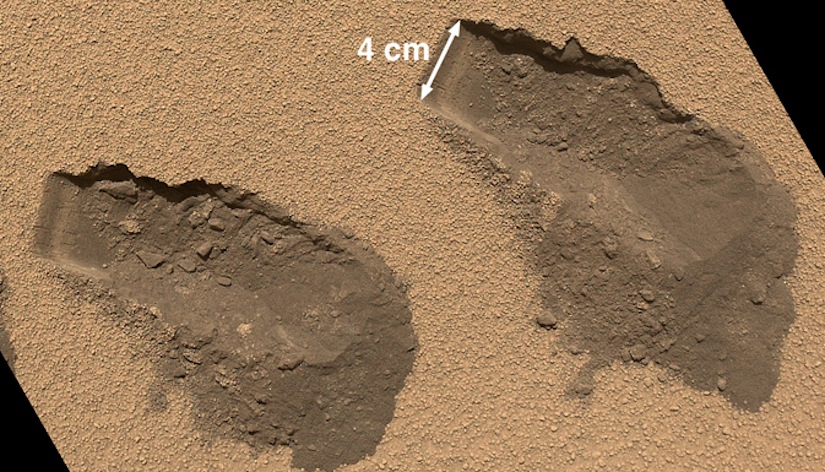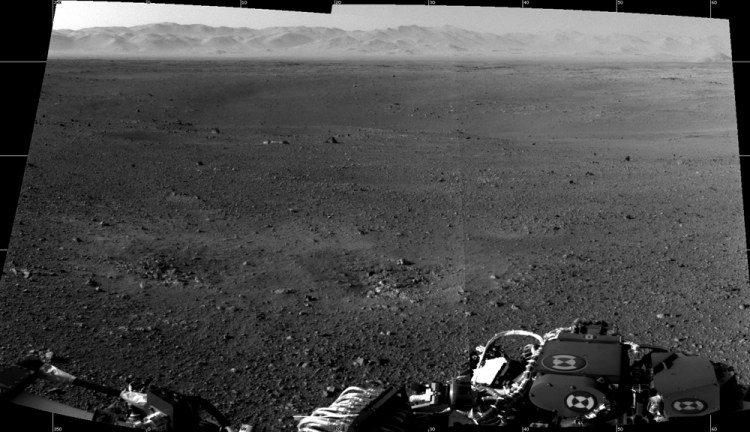Today marks the first anniversary of the Curiosity rover’s landing on Mars.
On August 5, 2012, we watched the lil’ guy (a.k.a. the one-ton hunk of thoroughly mobile scientific and mechanical engineering) make its way from the wilds of open space to the surface of the red planet. Since then, Curiosity has drilled into Martian rock with lasers, scooped up soil samples, found evidence of water, and set up an adorable Twitter account.
Here are some of our more notable Curiosity memories from the past year, and here’s to many more.
The descent
[youtube=http://www.youtube.com/watch?v=UcGMDXy-Y1I&w=853&h=480]
“This clip, which was just tweeted out by NASA, is the first video that shows Curiosity’s actual descent from onboard cameras — not a simulation, and not images from other spacecraft.
“The low-resolution video is a stop-motion clip shot at four frames per second by the Mars Descent Imager (MARDI), which was designed to help the rover/science laboratory land safely on the red planet’s surface.
“The clip shows the last two minutes or so of the descent, from the point at which the heatshield separated until the rover was on the ground.”
Here’s a high-res version that became available a couple weeks after the event:
[youtube=http://www.youtube.com/watch?v=RyBffhiOuVU&w=640&h=480]
The first photos
[vb_gallery id=504180]
“This morning, we’re taking a look at some of the first photos sent back from NASA’s latest mission to Mars, and they’re breathtaking.
“Even though they’re just black-and-white snaps showing little more than the rover’s wheels and a low-angle view of the Mars desert at sunset, they’re thrilling to those of us who get unreasonably excited about space travel and interplanetary exploration.
“Larger color images from other cameras are expected later in the week, when the rover’s mast, which carries high-resolution cameras, will be deployed.”
The first scoop
[youtube=http://www.youtube.com/watch?v=V10goCmY2FQ&w=853&h=480]
“The above video is another extraterrestrial first: Curiosity’s very first collection of Martian regolith via its robotic arm’s scooper, as seen from the rover’s mast camera.
“‘Here’s the scoop: I like my regolith shaken!’ the rover’s social media team tweeted of the clip, which shows the scoop full of Mars’ topmost layer and vibrating to sort the material.
“Regolith is a layer of dust, broken rock, and soil loosely covering solid rock. We get a bit of it here on Earth, and it’s also present on our own moon, some asteroids, and other planets, including Mars.”
Looking for water

“NASA’s Curiosity rover analyzed its first scoop on Mars and found water molecules in ‘higher than anticipated’ quantities, according to an announcement from the Jet Propulsion Laboratory (JPL) today.
“The water found attached to sand or other particles is ‘not unusual,’ according to JPL, but the quantities are surprising as the team looks for organic compounds in Martian soil.”
Seeing Mt. Sharp

“Mt. Sharp is the rover’s destination — rather, geological deposits around the mountain’s base, to be precise. The mountain towers 3.4 miles above Gale Crater, where the Curiosity rover first landed two weeks ago.
“The panorama is a stitched-up mosaic of 26 Navcam images taken in the wee hours of August 7/August 8, plus four new images taken on the 18th.”
The lasers
[vb_gallery id=523667]
“Lasers will come into play more as Curiosity rolls toward one of its targets, Glenelg, an intersection of three types of terrain near the rover’s landing site.
“‘The rover’s Chemistry and Camera [ChemCam] instrument shot its laser at rocks exposed by thrusters on the rover’s sky crane at the scour mark called Goulburn,’ we read on the ChemCam site today.
‘They show differences in brightness at the impact spot as well as a slight change in shadows. The inset shows an area about 1 square-inch [2.5 centimeters per side]. The target is about 19 feet [5.8 meters] away from the rover.'”
The time lapse
[youtube=http://www.youtube.com/watch?v=3FH6QPAD-BU&w=640&h=480]
“‘Just a minute!’ tweeted NASA’s always adorable Curiosity Rover this morning. ‘That’s all it takes to see 9 months of my mission thanks to fan @krsanford’s time lapse.’
“The labor of love in question is a 1-minute, 6-second YouTube clip showing an animated stream of raw images from the Front Hazard Avoidance Cameras, taken from NASA’s Curiosity pic dump.
“It’s an amazing thing to watch. You get to see landscapes change and time pass each day as the rover explores and travels across the red planet, casting its robotic shadow as it gathers samples and laser-drills into rock.”


